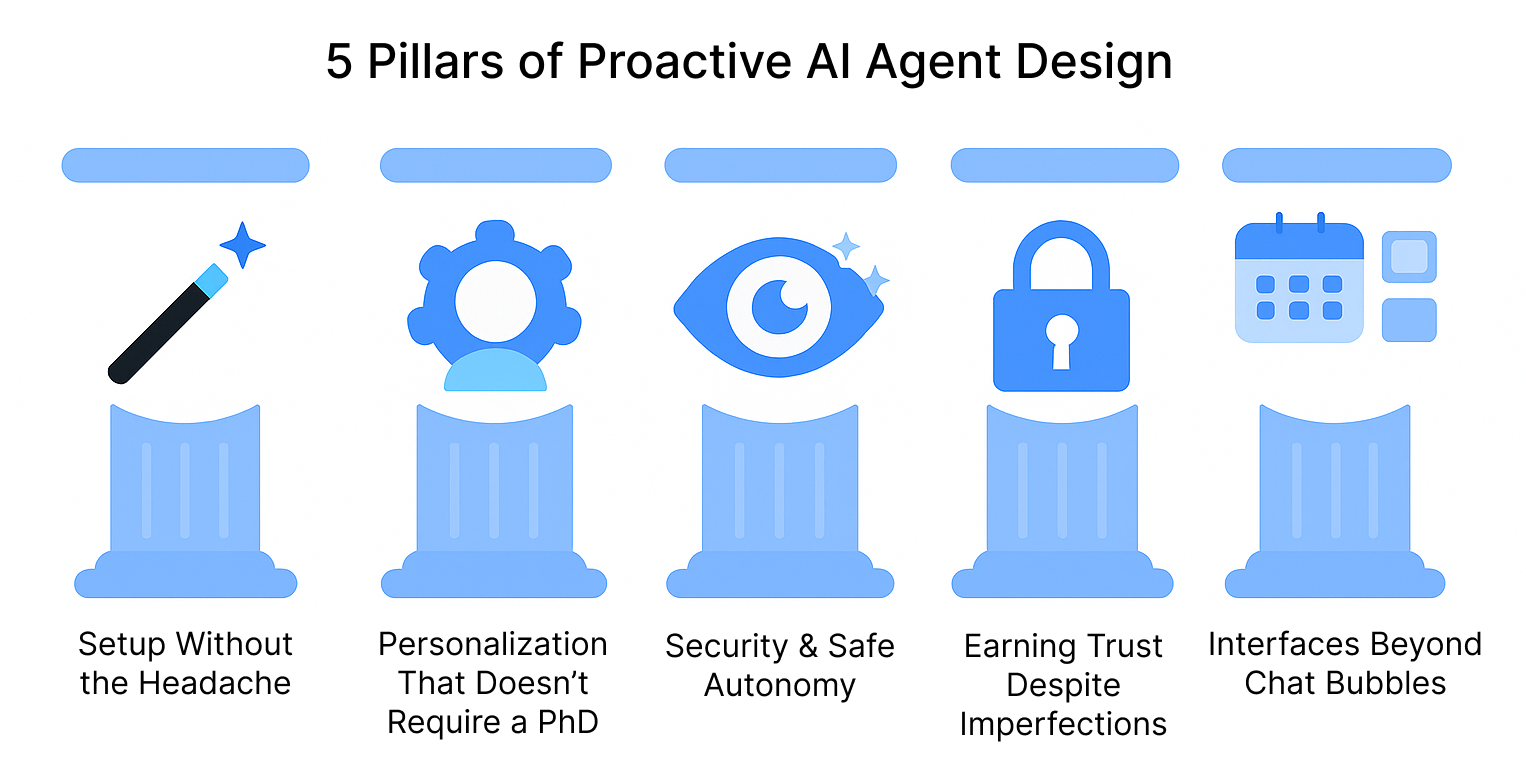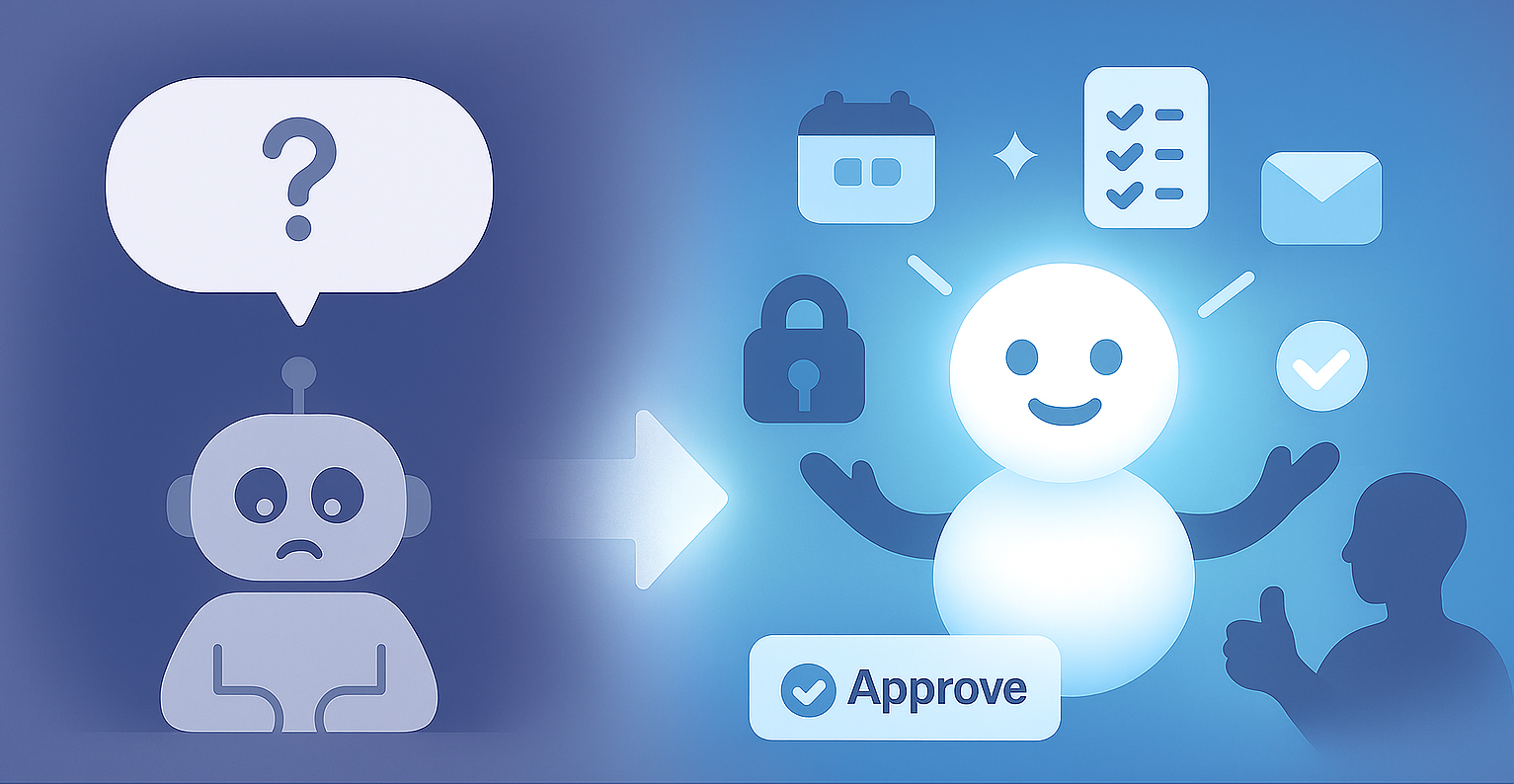Most AI helpers still stop at listen → label → leave the heavy‑lifting to you. Take meeting products, for instance: they can record every spoken word and spit out tidy bullet points—yet the moment real work begins they freeze. Proactive agents that plan, act and loop you in only when a human choice is truly needed are quickly becoming the next user interface paradigm.[1][2]
To make that leap we must extend assistants right up to—but not past—the decision boundary (the line where an autonomous action ends and human sign‑off begins) and keep the blast radius (the maximum harm a rogue agent could cause) razor‑thin—an approach already shaping enterprise orchestration tools.[3]
Let’s take note‑taking tools for example: the proactive agent should step in—not just labeling the past, but executing what comes next.
Right now, most AI meeting assistants can transcribe conversations, summarize key points, and propose action items like “schedule a follow-up” or “update CRM fields.” But that’s where they stop. You—the human—are still left to execute. That’s the limitation of today’s assistants.
Here’s how that same workflow transforms with a proactive agent:
Task 1: Schedule a follow-up call
| Today | With a proactive agent |
|---|---|
| You note the action item, then manually check everyone’s calendars, draft the invite, and send it out yourself. | It detects the follow-up intent, scans attendee availability across time zones, drafts the invite with a pre-filled agenda, and queues it for your approval—one tap and it’s sent. |
Task 2: Update CRM fields
| Today | With a proactive agent |
|---|---|
| After a meeting, you switch to your CRM, copy-paste notes, and manually adjust fields like deal stage or contact roles. | It recognizes the platform switch, drafts updates based on the meeting content, highlights the proposed changes, and cites the transcript as evidence—waiting for your “Approve.” |
Each scenario follows a draft‑then‑approve flow—an essential trust pattern confirmed in recent UX research on proactive agents.[4]
Designing Human‑Centered AI Agents
Designing a truly helpful AI agent isn’t just a technical challenge—it’s a user‑experience one. These five pillars focus on what matters from the user’s point of view: how easily they can set things up, how well the agent adapts to their preferences, how transparently it communicates, how safely it operates, and how naturally it fits into the way they work. It’s not about building smarter code—it’s about creating systems people trust, understand, and actually want to use.

1. Setup Without the Headache
Most users aren’t engineers. If connecting a calendar or CRM requires coding or configuration files, your agent has already lost them. Setup should feel like logging into a modern SaaS tool: seamless OAuth‑style integration, with smart defaults that handle the edge cases. Most importantly, agents should come with a draft‑then‑approve model enabled by default—giving users immediate control and confidence.
2. Personalization That Doesn’t Require a PhD
No two people work alike. Rather than relying on rigid templates or YAML configs, agents should learn by example. When a user edits a draft, ignores a suggestion, or reorders steps, the agent should capture that signal. Over time, it learns preferences, calibrates confidence thresholds, and knows when to ask for permission or act quietly. Personalization shouldn’t require configuration—it should emerge naturally.
3. Earning Trust Despite Imperfections
LLMs hallucinate; retrieval pipelines miss context. Those facts won’t disappear overnight. Proactive agents must make their reasoning visible: show confidence scores, highlight what changed and why, and offer rollback options. Whether it’s suggesting a message or updating a record, users should see not just the what, but the why—ideally in a form that’s quick to scan and easy to override.
4. Security & Safe Autonomy
Power without safety is risk. Giving agents write access should never feel like giving up control. Instead, systems should offer fine‑grained permissions (e.g., only edit certain fields), use policy sandboxes to restrict scope, and log every action for transparency. Paired with the draft‑then‑approve pattern, users stay in command even as agents do more on their behalf.
5. Interfaces Beyond Chat Bubbles
Chat is a great input mode—not always a great output mode. A user shouldn’t have to scroll through a message thread to approve a budget change or check a timeline. Instead, agents should use interfaces that fit the task: charts for trends, calendars for scheduling, kanban boards for workflows. Approvals and edits should appear inline, with minimal friction and no context switching.
Closing thought
Nail these pillars and an AI agent stops feeling like a glorified chatbot and starts feeling like the most reliable junior teammate you’ve ever onboarded—one that sets itself up, learns your quirks, works safely, and leaves you with nothing but the fun decisions.
References
Gates, Bill. AI-powered agents are the future of computing. GatesNotes. ↩︎
Poda, Margo. Mission: AI Possible — What Agentic AI Means for the Future of ITOps. LogicMonitor Blog. ↩︎
Knight, Will. Google’s AI Boss Says Gemini’s New Abilities Point the Way to AGI. WIRED. ↩︎
Diebel, Christopher, et al. When AI-Based Agents Are Proactive: Implications for Competence and System Satisfaction in Human–AI Collaboration. Business & Information Systems Engineering. ↩︎
